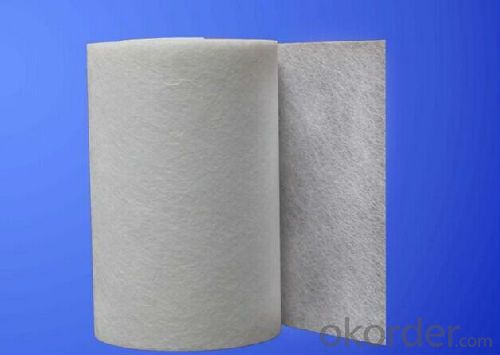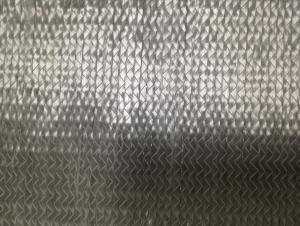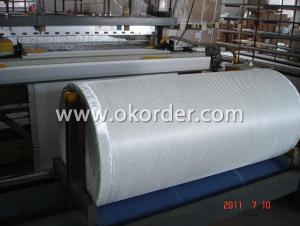Fiber Glass Surface Tissue Mat Low Binder Content
- Loading Port:
- China Main Port
- Payment Terms:
- TT or LC
- Min Order Qty:
- 2000kg kg
- Supply Capability:
- -
OKorder Service Pledge
OKorder Financial Service
You Might Also Like
Description
Surfacing Tissue mainly used in the surface layers of FRP products. It features even Fiber distribution, soft feel, level and smooth fiber surface, less glue content, quick resin soak and good pattern fitness. It can improve the product surface property on corrosion resistance, compressive strength, seepage resistance, and longer service life. It is also suitable for spraying; pattern pressing and other FRP pattern technology.
Product Features:
● Fast breakdown in styrene
● Fiber dispersed evenly
● Low binder content
● Superior acid corrosion resistance
Specifications
| item | unit | scc20w | scc30w | scc30w |
Area weight | g/m2 | 20 | 30 | 50 |
| binder content | % | 7 | 6 | 6 |
| tensile strength MD | N/5cm | ≥20 | ≥25 | ≥40 |
| soaking time | S | ≤8 | ≤10 | ≤16 |
| moisture content | % | ≤0.2 | ≤0.2 | ≤0.2 |

Product packaging:
Each Surface Tissue is wound onto a paper tube which has an inside diameter of 76mm and the mat roll has a diameter of 330mm. The mat roll is wrapped up with plastic film,and then packed in a cardboard box or wrapped up with kraft paper. The rolls can be vertically or horizontally placed. For transportation, the rolls can be loaded into a cantainer directly or on pallets.

FAQ:
1.What is the delivery time ?
15days after receiving the deposit
2.Are you a trading company or factory.
We are factory,and we have more than 10 years of experience.

- Q: Which is more durable, stone cotton or glass cloth?
- Asbestos is a specialized mineral that can be obtained by processing. Glass fiber is usually fused with quartz and alkali. The more alkali is added, the worse the performance is. Many processes require alkali free fiberglass.If you want to talk, open another question
- Q: Is fiberglass fabric suitable for use in electrical insulation tapes?
- Yes, fiberglass fabric is suitable for use in electrical insulation tapes. It has excellent electrical insulation properties, high resistance to heat and fire, and good mechanical strength. Additionally, it provides good dimensional stability and chemical resistance, making it a reliable choice for electrical insulation applications.
- Q: What are the different thickness options for fiberglass fabric rolls?
- The thickness options for fiberglass fabric rolls can vary, but commonly range from 0.5 oz to 6 oz per square yard.
- Q: What are the different finishes available for fiberglass fabric rolls?
- There are several different finishes available for fiberglass fabric rolls, each providing unique characteristics and benefits. Some common finishes include: 1. Plain: Plain finish refers to fiberglass fabric without any additional treatment or coating. It offers excellent strength and durability, making it suitable for a wide range of applications. 2. Silicone: Silicone-coated fiberglass fabric rolls are popular due to their exceptional heat resistance and non-stick properties. This finish provides excellent release properties, making it ideal for applications involving high temperatures or sticky materials. 3. Aluminized: Aluminized finish involves applying a layer of aluminum to the surface of the fiberglass fabric. This finish offers excellent heat reflection properties, making it suitable for applications where heat insulation is required. 4. Vermiculite: Vermiculite-coated fiberglass fabric rolls provide enhanced fire resistance and heat insulation capabilities. The vermiculite coating expands when exposed to high temperatures, creating a protective barrier against heat and flames. 5. PTFE: PTFE (polytetrafluoroethylene) coating is often applied to fiberglass fabric to enhance its chemical resistance and non-stick properties. This finish is commonly used in applications involving corrosive chemicals or where easy release is required. 6. PVC: PVC (polyvinyl chloride) coating is applied to fiberglass fabric to provide additional protection against chemicals, oil, and moisture. It also offers increased strength and flexibility, making it suitable for various industrial applications. These are just a few examples of the finishes available for fiberglass fabric rolls. Depending on the specific requirements of an application, there may be additional finishes or combinations of finishes that can be utilized to meet the desired functionality and performance.
- Q: Is fiberglass fabric suitable for making protective clothing?
- Yes, fiberglass fabric is suitable for making protective clothing. It is known for its fire resistance, high strength, and durability, making it an ideal choice for protective gear in industries such as firefighting, welding, and chemical handling. Additionally, fiberglass fabric offers excellent insulation properties and is resistant to chemicals, making it a reliable material for protecting against hazards.
- Q: Is fiberglass fabric resistant to high temperatures?
- Yes, fiberglass fabric is highly resistant to high temperatures. It can withstand temperatures up to 1000 degrees Fahrenheit without melting or degrading, making it suitable for various applications that involve exposure to extreme heat.
- Q: What is the weight of fiberglass fabric?
- The weight of fiberglass fabric may differ based on the particular type and thickness of the fabric. Typically, fiberglass fabric is quantified in ounces per square yard (oz/yd2) or grams per square meter (g/m2). Fiberglass fabric is typically available in weights ranging from 0.5 oz/yd2 (17 g/m2) to 3.0 oz/yd2 (102 g/m2) or beyond. Lightweight fiberglass fabrics are often employed in applications like reinforcement and lamination, whereas heavier fabrics find common use in structural reinforcement or insulation objectives.
- Q: What are some popular brands of fiberglass fabric?
- Some popular brands of fiberglass fabric include Owens Corning, 3M, Hexcel Corporation, Saint-Gobain, and Jushi Group. These brands are well-known for their high-quality fiberglass fabrics that are used in a wide range of industries such as automotive, aerospace, construction, and marine. Owens Corning, for example, is a leading manufacturer of fiberglass materials and offers a variety of fabric options for different applications. 3M is another trusted brand that provides fiberglass fabric with excellent thermal resistance and durability. Hexcel Corporation is known for its advanced composite materials, including fiberglass fabrics, which are highly sought after in the aerospace industry. Saint-Gobain is a global leader in fiberglass fabric production, offering a wide range of specialty fabrics for various industries. The Jushi Group is one of the largest producers of fiberglass in the world and supplies high-quality fiberglass fabrics to global markets. These popular brands are known for their commitment to quality and innovation, making them trusted choices for fiberglass fabric needs.
- Q: What is the maximum width available for fiberglass fabric rolls?
- The maximum width available for fiberglass fabric rolls can vary, but typically it ranges from 1 meter (39 inches) to 3 meters (118 inches).
- Q: Is fiberglass fabric resistant to chemicals used in aerospace industry?
- Yes, fiberglass fabric is highly resistant to the chemicals used in the aerospace industry. Fiberglass is made from strands of glass that are woven together, resulting in a strong and durable material. This fabric is known for its excellent chemical resistance, making it suitable for a wide range of applications in the aerospace industry. Fiberglass fabric can withstand exposure to various chemicals, including fuels, lubricants, solvents, and hydraulic fluids, without significant degradation or damage. This chemical resistance is crucial in aerospace applications, where the materials used must be able to withstand harsh environments and maintain their structural integrity. Overall, fiberglass fabric is an ideal choice for the aerospace industry due to its exceptional chemical resistance properties.
Send your message to us
Fiber Glass Surface Tissue Mat Low Binder Content
- Loading Port:
- China Main Port
- Payment Terms:
- TT or LC
- Min Order Qty:
- 2000kg kg
- Supply Capability:
- -
OKorder Service Pledge
OKorder Financial Service
Similar products
Hot products
Hot Searches
Related keywords




























